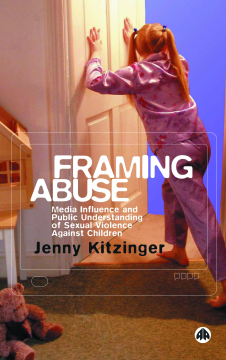
Additional Information
Book Details
Abstract
How does the media shape the way we think about child sexual abuse? Combining in-depth analysis of media representations of the crimes, with focus group discussions and interviews with around 500 journalists, campaigners and a cross-section of 'the public', Jenny Kitzinger reveals the media's role in contemporary society.
Which stories attract attention and why? Answering this and other questions, Kitzinger demonstrates how media reporting can impact on people's knowledge of the 'facts', perceptions of risk, sense of appropriate policy responses and even how we interpret our own experiences. Looking at feminist initiatives to challenge sexual violence, the emergence of incest as a social problem and the development of new survivor identities. She also explores stereotypes around sex offenders,interrogates protests against 'paedophiles-in-the-community' and presents a detailed analysis of the impact of scandals about disputed abuse accusations.
This book is essential reading for anyone interested in theories of media influence, identity and social change or who wishes to encourage responsible journalism. It is also a key resource for anyone concerned about sexual violence and the protection of children or who is attempting to design intervention strategies.
Table of Contents
| Section Title | Page | Action | Price |
|---|---|---|---|
| Contents | vii | ||
| 1 Introduction | 1 | ||
| The research that informs this book | 1 | ||
| A guide to the book's structure | 7 | ||
| 2 The Debate About Media Influence | 11 | ||
| A review of some key approaches to audience research | 12 | ||
| The current impasse: media influence versus active audiences | 24 | ||
| My research approach | 27 | ||
| 3 Transformation of Private and Public Discourse: The Media 'Discovers' Sexual Abuse | 32 | ||
| Constructing a new social problem: a brief modern history | 32 | ||
| Placing narratives in historical context: recording personal accounts during the 1980s and 1990s | 37 | ||
| From cultural vacuum to multiple media mediation: survivors™ accounts of the media™s role | 37 | ||
| The preconditions for media discovery | 44 | ||
| Critical refl ections on coverage of ‚ the incest survivor™ | 46 | ||
| Revisiting three media studies theories: active consumption, creative identifi cation and agenda- setting | 47 | ||
| Conclusion | 53 | ||
| 4 Media Templates: Controversial Allegations and Analogies | 54 | ||
| The media's discovery of contested cases | 54 | ||
| The Cleveland scandal: a brief introduction | 56 | ||
| Journalists' retrospective references to Cleveland | 57 | ||
| Public recollections of Cleveland | 59 | ||
| Challenging templates: an alternative media account of the Cleveland scandal | 66 | ||
| Discussion | 69 | ||
| Conclusion | 78 | ||
| 5 Story Branding and the Role of Empathy | 79 | ||
| Orkney in the news - an outline of the scandal | 79 | ||
| Remembering Orkney as 'the dawn raids case' | 84 | ||
| Why the dawn raids made such an impression | 88 | ||
| Reflections on the dawn raids branding | 93 | ||
| Sources of alternative perspectives | 98 | ||
| Conclusion | 101 | ||
| 6 Story Placing: Representing Localities, Landscapes and Communities in the News | 103 | ||
| The significance of place in news reporting | 103 | ||
| Locating the story in landscape and community: media accounts of Orkney | 105 | ||
| People's memories of how the media represented Orkney | 109 | ||
| People's impressions and beliefs | 113 | ||
| Conclusion | 122 | ||
| 7 Social Currency, Stranger- Danger and Images of Abusers | 125 | ||
| Beasts, devils, queers and sissies: images of sex offenders | 125 | ||
| The danger that prowls our streets | 128 | ||
| Public perceptions of abusers | 129 | ||
| A reflection on representations of accused adults in contested cases | 136 | ||
| 'Public' and 'private' knowledge: extra- media influences and the signifi cance of social currency | 138 | ||
| Conclusion | 142 | ||
| 8 Audiences as Activists: The 'Paedophile in the Community Protests | 144 | ||
| The rise of the paedophile problem | 145 | ||
| 'Moral panics and lynch mobs'? | 148 | ||
| Theorising community and media protest | 149 | ||
| Conclusion | 158 | ||
| 9 The Zero Tolerance Campaign: Responses to a Feminist Initiative | 159 | ||
| The Zero Tolerance campaign | 159 | ||
| Researching people's responses | 163 | ||
| Conclusion | 177 | ||
| 10 Conclusion | 180 | ||
| The media's role in representing social issues | 181 | ||
| How texts 'work' | 183 | ||
| How audiences 'work' | 183 | ||
| Reflections on key terms and the implications of audience activity for media influence | 188 | ||
| Implications for future research | 191 | ||
| Epilogue: Implications for Journalists and for Child Protection | 195 | ||
| Implications for child protection | 195 | ||
| Implications for media professionals | 196 | ||
| Reflections on the political economy of the media | 199 | ||
| Appendix | 201 | ||
| Notes | 204 | ||
| References | 216 |
